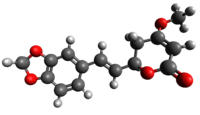Methysticin
Appearance
 | |
 | |
| Names | |
|---|---|
| Preferred IUPAC name
(6R)-6-[(E)-2-(2H-1,3-Benzodioxol-5-yl)ethen-1-yl]-4-methoxy-5,6-dihydro-2H-pyran-2-one | |
| Identifiers | |
3D model (
JSmol ) |
|
| ChemSpider | |
| KEGG | |
PubChem CID
|
|
| UNII | |
CompTox Dashboard (EPA)
|
|
| |
SMILES
| |
| Properties | |
| C15H14O5 | |
| Molar mass | 274.272 g·mol−1 |
Except where otherwise noted, data are given for materials in their standard state (at 25 °C [77 °F], 100 kPa).
| |
Methysticin is one of the six major kavalactones found in the kava plant.[1] Research suggests that methysticin and the related compound dihydromethysticin have CYP1A1 inducing effects which may be responsible for their toxicity.[2] Additionally, methysticin has been shown to potentiate GABAA receptor activity, contributing to the overall anxiolytic profile of the kava plant.[3]
Toxicity
Methysticin induces the function of the hepatic enzyme CYP1A1. This enzyme is involved in the
toxification of benzo[a]pyrene into (+)-benzo[a]pyrene-7,8-dihydrodiol-9,10-epoxide, a highly carcinogenic substance. Another related compound is dihydromethysticin, which also induces the function of CYP1A1.[2][4][5] No report so far has described enhancement of CYP1A1 expression in animals or humans in vivo from any constituent of kava.[6]
References
- ^ Malani, Joji (2002-12-03). "Evaluation of the effects of Kava on the Liver" (PDF). Fiji School of Medicine. Archived from the original (PDF) on 2009-03-20. Retrieved 2009-09-04.
- ^ PMID 21908763.
- S2CID 45511040.
- PMID 8313840.
- S2CID 24627183.
- PMID 18930106.
